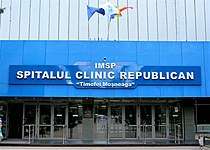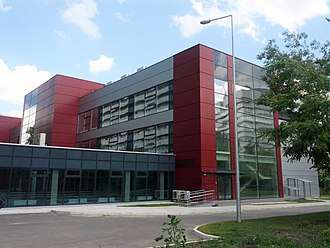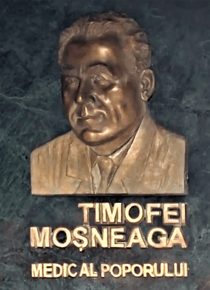Timofei Moșneaga Republican Clinical Hospital
| Timofei Moșneaga Republican Clinical Hospital | |
|---|---|
 | |
 | |
| Geography | |
| Location | Nicolae Testemițanu 29 St., Chișinău, Moldova |
| Coordinates | 46°59′36.612″N 28°50′0.518″E / 46.99350333°N 28.83347722°ECoordinates: 46°59′36.612″N 28°50′0.518″E / 46.99350333°N 28.83347722°E |
| Organisation | |
| Hospital type | General |
| Affiliated university | Nicolae Testemițanu State University of Medicine and Pharmacy |
| Services | |
| Emergency department | No |
| Beds | 795 |
| History | |
| Founded | 1817 |
| Links | |
| Website |
www |
| Other links |
www |
|
| |
The Timofei Moșneaga Republican Clinical Hospital (Romanian: Spitalul Clinic Republican „Timofei Moșneaga”) is the first and largest medical institution in Moldova with 795 beds and 20 hospital departments. It is the clinical base of 15 departments and advanced courses of the Nicolae Testemițanu State University of Medicine and Pharmacy. It is named after Timofei Moșneaga, the hospital's longest-tenured director, who led the institution for 43 years.
History
At the beginning, the Timofei Moșneaga Republican Clinical Hospital (RCH) had the status of a municipal hospital, being the first medical institution in Bessarabia built with the support of sponsors and citizens of Chisinau. The hospital was officially opened on December 26, 1817.
The first building of the municipal hospital had one and a half levels, hosting 5 wards with 36 beds, where patients with therapeutic, surgical and gynecological problems were treated. The medical staff was providing ambulatory medical services as well.

In 1842, taking into consideration the growing needs of the institution, another building was built, offering place for specialized units of therapy, surgery, ophthalmology and sexually transmissible diseases. In 1860, the staff of the hospital comprised a medical doctor (who was, at the same time, the manager), one senior medical assistant, 3 inferior medical assistants, 27 nurses, a linen mistress, a clerk, a copyist and a priest. A pharmacy was also functioning on the hospital premises.
In the year 1870, the second stage in the hospital's history started, the institution being transferred in the subordination of the gubernskoe zemstvo (the government of the province). From then its name was changed into Gubernial Hospital and it already had a capacity of 100 beds and a staff comprising 13 medical doctors and 40 medical assistants.
As time went by, the need in medical staff, especially in medical assistants and midwives, was becoming more and more pregnant. As an answer to these necessities, in 1872, under the auspices of the Gubernatorial Hospital, the school of medical assistants and midwives was founded. The first promotion (17 students) finished the school in 1873 and remained to work at the hospital.
In 1876, a number of special units - for various tests, microscopy, morphopathology and even a unit devoted to experiments on animals - were opened. In order to stop the expansion of infectious diseases, the first unit for vaccination against smallpox was organized. Along years, the Gubernatorial Hospital is becoming an important centre for the education and continuous training of doctors from the cities and districts of Bessarabia.
The disastrous consequences of the two World Wars of the first half of the 20th century gravely affected the activity of the Gubernial Hospital. The bombings transformed its buildings in ruins, thus it had to be completely rebuilt and equipped with modern technological and medical installations and equipment.It is already bearing a different name - the Republican Clinical Hospital. The institution will become, in time, the clinical base for the Chisinau Institute of Medicine.

In 1967, when the Hospital was celebrating its 150th anniversary, it had 10 units for stationary treatment, a republican consulting polyclinic for the inhabitants of rural areas, an AVIASAN (sanitary aviation) department, numerous labs and diagnostic rooms, fitted with modern equipment. New units were already functioning: anesthesiology, endocrinology, cardiovascular, thoracic and maxillofacial surgery. The artificial kidneys unit was also opened here, among the first in the Soviet Union. The most valuable clinical methods are implemented in diagnostics practice: laparoscopy, splenetic portography, phlebography, electro-chemiography and others. Extra corporeal dialysis and cardiac defibrillation are applied, new methods of anesthesia are successfully implemented, and laboratory of nuclear medicine is created. The most complex pulmonary and vascular surgeries are effectuated, the abdominal surgery is being permanently improved and, in 1961, the first successful heart surgery is taking place. By 1966, 10 000 patients have been given medical care at the RCH. In 1977, the Republican Clinical Hospital moved into new premises. This new, modern location permitted to significantly raise the quality and efficiency of medical care given to the population, to improve and diversify the diagnostics methods and the activity of labs and specialized units. As a result, over 200 new methods of diagnostics and treatment have been implemented in hospital practice.

The professional level of the staff is also on continuous raise. In the period 1966-1996, 50 medical doctors were awarded the degree of PhD in medicine, while 5 obtained the M.D. degree. Our specialists take part in international congresses, symposium and conferences, presenting their valuable reports.
During the first period of transition to a free market economy the hospital has been in a rather difficult situation which started to change for the better with the implementation, in 2004, of the system of medical insurance. Presently, the hospital is functioning on the basis of a contract with the National Company for Medical Insurance (NCMI), thus the institution being ensured a rhythmic financing. The benefices of this system of medical insurance are obvious - there are no problems in drugs supplying, the hospital is being frequently reequipped with modern medical equipment, new medical services and treatment methods are implemented, especially in the field of surgery, including the noninvasive surgery. For the first time the number of diagnostic investigations over/passed the figure of one million. The quota of rural inhabitants in the overall number of patients treated by the specialists of the hospital represents more than 85%.
Nowadays, the Timofei Moșneaga Republican Clinical Hospital has 795 beds and 20 units, the patients being given care by 1300 qualified specialists. It is the clinical base of 12 departments of the Nicolae Testemițanu State University of Medicine and Pharmacy and of its program of continuous training. In collaboration with the teaching staff of the University, the specialists of the hospital are able to give medical care of the highest quality.